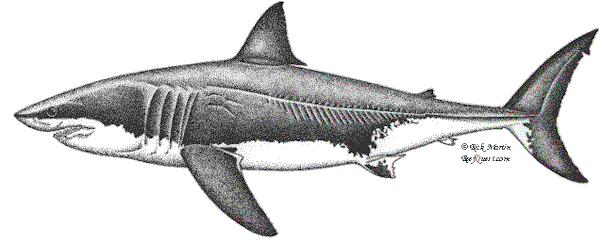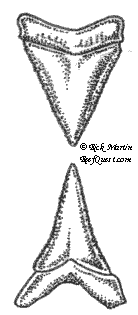| |
Biosketch of the White Shark
Recognition:
- body heavy, spindle-shaped, with conical snout and narrow tail stalk
supported by stout lateral keels
- long gill slits, extending about 2/3 the depth of the throat
- mouth armed with teeth that are relatively few but large
- second dorsal and anal fins small, with pivoting bases
- caudal fin lunate, with lower lobe nearly as large as the upper
- teeth triangular and serrated
- eyes small but conspicuous, black with no visible pupil
- origin of first dorsal fin over rear base of pectoral fins
- sharp demarcation between dark upper surfaces and white lower surfaces;
trailing edge of pectoral fin white, underside of pectoral tips black; a
black spot occurs at the pectoral axil ("armpit") in some individuals

Size:
- at birth: 3-5 feet (1-1.5 meters)
- at maturity: males 11.5-12 feet (3.5-3.6 meters), females 15-16 feet (4.5-5 meters)
- maximum: 20+ feet (6+ meters), possibly to 26 feet (8 meters)
Reproduction:
- age at maturity: males 9-10 years, females 14-16 years
 reproductive mode: ovoviviparous, with oophagy reproductive mode: ovoviviparous, with oophagy- gestation period: 14 months
- number of pups: 5-10, possibly to 17
Diet:
- juvenile: bottom-dwelling teleost fishes, invertebrates, small sharks and rays
- adult: sharks, rays, teleost fishes, seals, sea lions, dolphins, whale
blubber, squids, seabirds, marine turtles, crabs, snails
Habitat Types:
- sandy plains, rocky reefs, kelp forests, coral reefs, deep sea, polar seas
Depth Range:
- surface to 6150 feet (1875 meters)
Global Distribution (by Zoogeographic Region):
- Central Pacific, South Pacific, Western Pacific, Temperate Eastern Pacific, Tropical
Eastern Pacific, Peruvian, Western North Atlantic, Caribbean, Argentinean,
Eastern North Atlantic/Mediterranean, West African, Southern African,
Madagascaran, Arabian, Southeast Asian, Western Australian, Southeast
Australian/New Zealand, Northern Australian
|